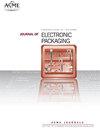Fracture Behavior and Reliability of Low-Silver Lead-free Solder Joints
IF 2.3
4区 工程技术
Q3 ENGINEERING, ELECTRICAL & ELECTRONIC
引用次数: 2
Abstract
Low-silver solders are increasingly being used because silver improves the tensile strength. In this study, the variation in fracture behavior with silver content in lead-free solder joints were studied using double cantilever beam specimens. Fracture tests were done with solder joints made with Sn-0.7Cu, SACX0307, and SAC305 solder materials. The critical energy release rate for crack-initiation (Gci) of the joint was correlated with the plastic zone just ahead of the pre-crack tip, intermetallic compound layer thickness, energy dispersive spectroscopy analysis, and scanning electron microscopy based fractography study. The Gci for Sn-0.7Cu solder joint was observed to be significantly higher than the other two solder joints. The fractography study revealed that the failure was ductile for Sn-0.7Cu and a mix of ductile and brittle for the other two solder joints. The extent of the plastic zone ahead of the crack tip, obtained from finite element modeling, was found to be significantly larger and the intermetallic compound layer was relatively thinner for Sn-0.7Cu solder joint compared to the other two solder joints. The ductile failure, significantly larger plastic zone size and thinner intermetallic compound layer resulted in significantly higher Gci for Sn-0.7Cu solder joint.低银无铅焊点的断裂行为与可靠性
由于银提高了抗拉强度,因此越来越多地使用低银焊料。在本研究中,使用双悬臂梁试样研究了无铅焊点中断裂行为随银含量的变化。用Sn-0.7Cu、SACX0307和SAC305焊料材料制成的焊点进行断裂测试。接头裂纹萌生的临界能量释放率(Gci)与裂纹尖端前的塑性区、金属间化合物层厚度、能量色散光谱分析和基于扫描电子显微镜的分形研究相关。Sn-0.7Cu焊点的Gci明显高于其他两个焊点。断口形貌研究表明,Sn-0.7Cu的失效是韧性的,其他两个焊点的失效是延性和脆性的混合。通过有限元建模获得的裂纹尖端之前的塑性区的范围被发现明显更大,并且与其他两个焊点相比,Sn-0.7Cu焊点的金属间化合物层相对更薄。韧性失效、较大的塑性区尺寸和较薄的金属间化合物层导致Sn-0.7Cu焊点的Gci显著较高。
本文章由计算机程序翻译,如有差异,请以英文原文为准。
求助全文
约1分钟内获得全文
求助全文
来源期刊

Journal of Electronic Packaging
工程技术-工程:电子与电气
CiteScore
4.90
自引率
6.20%
发文量
44
审稿时长
3 months
期刊介绍:
The Journal of Electronic Packaging publishes papers that use experimental and theoretical (analytical and computer-aided) methods, approaches, and techniques to address and solve various mechanical, materials, and reliability problems encountered in the analysis, design, manufacturing, testing, and operation of electronic and photonics components, devices, and systems.
Scope: Microsystems packaging; Systems integration; Flexible electronics; Materials with nano structures and in general small scale systems.
 求助内容:
求助内容: 应助结果提醒方式:
应助结果提醒方式:


